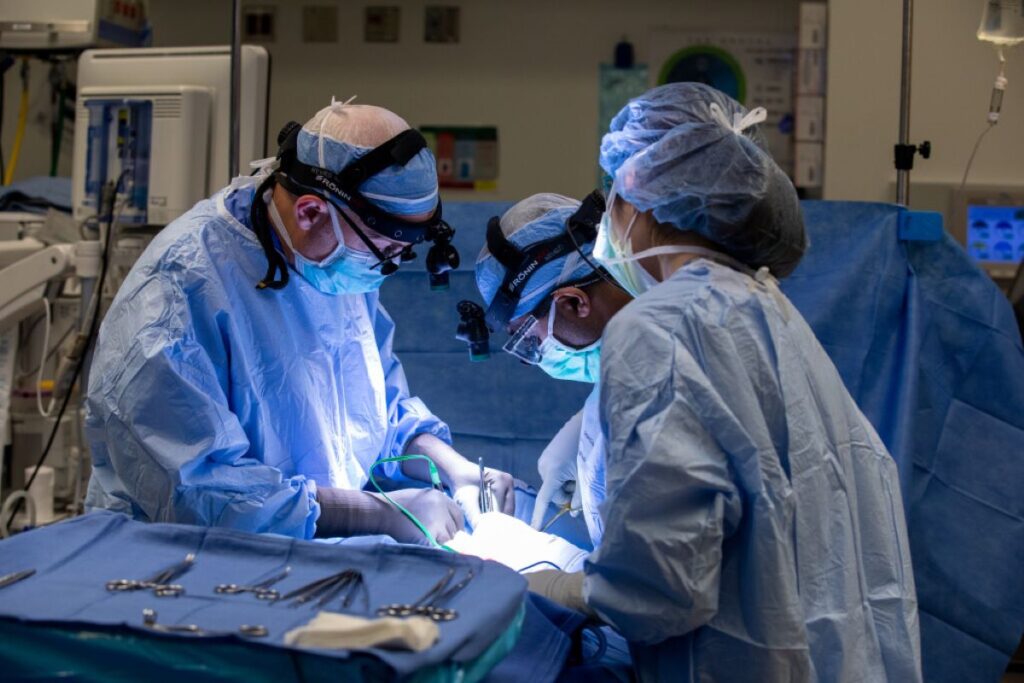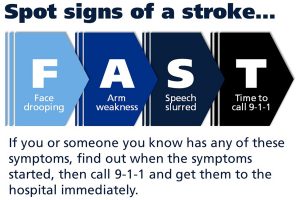
Dr. Michael Sather (left) leads a surgery to implant a Vivistim Pair VNS system in a patient at Penn State Health Milton S. Hershey Medical Center.
Donald Eagle lived a “new normal” for the first seven and a half years after suffering a severe stroke. After spending a week in the intensive care unit at Penn State Health Milton S. Hershey Medical Center, he spent 40 days at Penn State Health Rehabilitation Hospital learning to walk again. However, the function of his left arm or hand never returned.
February 23, 2024
“You just adjust. I learned to use my right hand,” said Eagle, who has been left-handed his whole life.
The pastor of Newville Shepherd's Gate Worship Center Church of God in Cumberland County said it was God who took Mr. Eagle to Milton S. Hershey Medical Center for life-saving treatment immediately after his stroke. I believe it was because of the intervention. And he once again credits God with leading him to the same place where his neurologist told him about a new treatment for his limited mobility during a routine visit last summer. There is.
The Vivistim Paired VNS (vagus nerve stimulation) system combines a surgically implanted device with physical or occupational therapy for people with moderate to severe upper arm disability after a stroke. The treatment, approved by the U.S. Food and Drug Administration (FDA) in 2021, is designed for chronic stroke patients, at least six months to more than 20 years after their stroke, patients like Eagle.
In 2022, Milton S. Hershey Medical Center became one of the first medical facilities in the country to use Vivistim and the first in the state to use Vivistim. The hospital remains the only hospital in central Pennsylvania to offer it.
“Until recently, many post-stroke clinical studies have been conducted, but there has been little promise regarding stroke motor recovery beyond standard physical therapy and occupational rehabilitation therapy,” said the Stroke Division Joint Director Dr. Raymond Reichwein said. He is the medical director of the Penn State Health Comprehensive Stroke Center and a professor of neurology at the Penn State College of Medicine. “Vivistim allows us to take neurological stroke recovery to the next level. It also leads to the optimal development of post-stroke rehabilitation and recovery networks.”
innovative surgery
The first step in the new treatment is a surgical procedure that involves implanting a small device under the skin in the upper chest. The surgeon then attaches the device to a wire under the skin that leads to an electrode placed on the left vagus nerve in the neck. The entire procedure usually takes just over an hour.
“This surgical procedure has been around for decades,” said Dr. Michael Sather, surgical director of the Comprehensive Epilepsy Center at Milton S. Hershey Medical Center and professor of neurosurgery at Penn State College of Medicine. said. “This is a new device and treatment for chronic stroke recovery.”
Approximately 1 to 2 weeks after the Vivistim device is implanted, patients begin intensive rehabilitation therapy (three 90-minute sessions per week for 6 weeks) focused on the affected arm, hand, and wrist. start.
During each session, a physical therapist or occupational therapist specially trained in the Vivistim system uses a wireless transmitter to activate the device and the patient receives customized neural-based therapy to address their specific deficiencies. Participate in During treatment, patients can perform 30 to 50 repetitions of targeted arm, hand, and wrist movements, for a total of approximately 300 purposeful movements per session.
“I knew it was going to be a lot of work, thanks to the intensive physical therapy I received when I learned how to walk again in 2016,” said Penn State Health Sciences in Hershey with Pam Hudson. Eagle said after completing a therapy session. , occupational therapist. “I was totally prepared for that.”
After patients complete six weeks of intensive treatment, they continue with one or two sessions per week, depending on their needs. These sessions can be delivered in a clinical setting with a therapist or through self-therapy at home. Patients use magnets to activate the device for about 30 minutes each time up to eight times a day to work on improving their disability.
Mark Lionti, who lives in Redding and suffered a stroke in 2018, went to Milton S. Hershey Medical Center last July to have the Vivistim device surgically implanted. He was able to receive all subsequent treatment sessions at Penn State Health St. Joseph Medical Center.
Improved functionality and visibility
Treatment with Vivistim has been shown to significantly improve arm and hand strength and dexterity in some stroke patients. But Reichwein said Penn State Health patients like Eagle and Lionti are also reporting significant improvements in their quality of life.
“That's the most important thing to me,” Reichwein said. “Our patients feel that their quality of life is much better with this treatment than without it.”
Eagle said the treatment opened up her world and “gave me a sense of new possibilities.” It’s just an expansion of what I think I can do,” he explained. “I'm now able to think outside of this 'stroke box' that I've lived in for years.”
Currently, Vivistim is FDA-approved only for use in the upper extremities, but Sather hopes it will be studied to help treat other stroke-related problems, such as leg and speech disorders.
“What's so interesting about the vagus nerve is that it's a relatively large nerve with connections throughout the brain, so it could potentially be used to treat a variety of diseases,” Professor Sather said. .
For now, people like Eagle and Lionty are grateful that innovative treatments have improved the movement of their arms and hands.
Lionty, who was an avid golfer before Stroke, recently took out his putter. He places it in his left hand, covers it with his right hand, and practices putting it into motion in the basement. “It's really good to be able to do that now,” he said.
Eagle is now able to gesture with his left hand during sermons and is practicing handwriting using a children's tracing book. As he and his wife, Gail, look forward to his next trip to Cracker Barrel, golf, or at least golf tees, plays an important role in his future plans.
“They have a peg game, a wooden triangular platform with a golf tee in a little hole,” Eagle said. He has not played in a game since 2016. “Now that I've got my fingers moving, I can't wait to get my hands on the tee.”
If you have trouble accessing this content or would like it in another format, please email Penn State Health Marketing & Communications.



